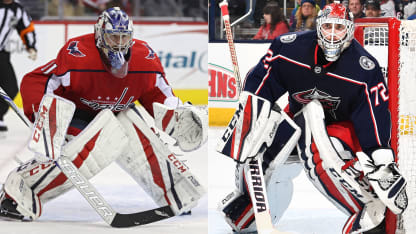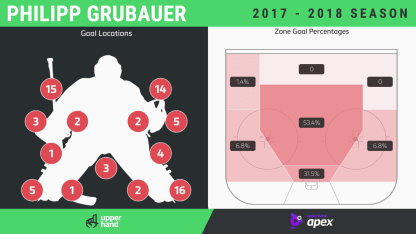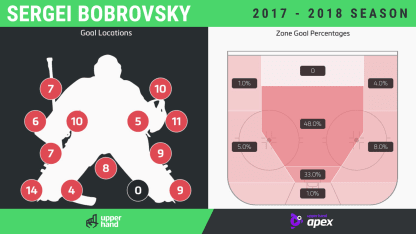Lateral plays and quick shots: Beating the two-time and defending Vezina Trophy winner isn't easy, so it should come as no surprise that 46 percent of the tracked goals scored on Bobrovsky were the result of plays and passes across the slot line, an imaginary line splitting the offensive zone from the goal line to the top of the face-off circles. Those goals are not measured as a save percentage, so we don't know how many Bobrovsky faced. We do know those chances are inherently more difficult for a goaltender because they force a change in angle while moving laterally. Half of the successful slot-line chances were finished with a one-timer or one-touch shot, emphasizing the need to get a shot off quickly against one of the NHL's fastest goalies.
Right off the rush: According to the data compiled for this project during the past two seasons, 38.5 percent of goals scored come off the rush, the other 61.5 percent after a team has set up in the attacking zone. Bobrovsky allowed 48 of the 100 goals tracked off the rush, second-most after Marc-Andre Fleury of the Vegas Golden Knights (49). This is not a save percentage and likely is an indicator of the willingness of the Blue Jackets to play an up-tempo, sometimes-risky style with Bobrovsky as the last line of defense. As for trends accompanying these chances, 19 of 28 against-the-grain goals, where the puck or play is moving one way and is shot or pulled back in the other direction, came off the rush. Seventeen of 21 clean goals, when he could set and see the shot's release, also came off the rush. Part of it was catching Bobrovsky, an active goalie who plays with backward flow, in motion. This is more pronounced in moving to his right, which is more likely to include a C-cut motion with his lead leg that can leave him slightly off the angle while moving and later in setting the angle once he arrives.
Skate on post: Bobrovsky is powerful moving into and off of his posts. He is able to take away the entire bottom of the net with a skate on each post when play is behind the net. He gave up five sharp-angle goals among the 100 tracked, but the only worrisome trend might be the gap between the bottom of his pad and the post when his skate blade is up against it.
Noticeable numbers: The only location numbers higher than the averages of the 16 playoff goalies were under-the-blocker (10 goals) and outside-the-blocker skate (14), many the result of the movement patterns when he's traveling left to right.




















